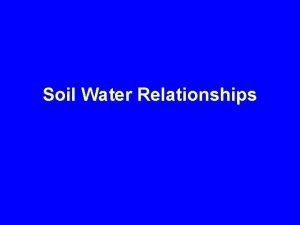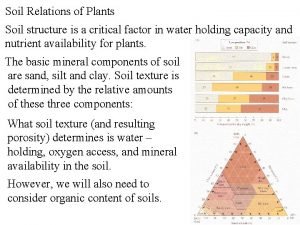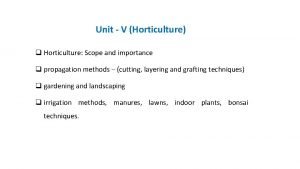Horticulture Science Lesson 27 Understanding Moisture Holding Capacity





















- Slides: 21

Horticulture Science Lesson 27 Understanding Moisture Holding Capacity

Interest Approach Place a jar of pure sand a jar of black soil before the students. Ask them which of the samples would produce the best crops. There may be a variety of answers. Lead the discussion in the direction of how much water would be available to plants growing in each of the samples. Which sample will provide the most moisture to the plants? Why? After a consensus is reached, identify specific objectives and possible problems for this lesson.

Student Learning Objectives • Describe moisture-holding capacity. • Explain what determines a soil’s moisture-holding capacity. • Determine the moisture-holding capacity of a given soil profile.

Terms • • available soil moisture available water-holding capacity capillary moisture gravitational moisture hygroscopic moisture infiltration leaching

Terms • • • moisture-holding capacity percolation permeable soil moisture tension unavailable soil moisture

What is moisture-holding capacity? • Moisture-holding capacity is the ability of the soil within the soil profile to retain water. • Water, which accounts for about 25% of the soil, is also part of the pore space in the soil. • When it rains, water will enter the soil or flow off of the soil’s surface.

What is moisture-holding capacity? • The process of water soaking into the soil is known as infiltration.

What is moisture-holding capacity? • Once water is in the soil, it moves downward in a process known as percolation. • A quality soil allows both kinds of water movement and is said to be permeable. • Water in the soil may be one of three types: gravitational, capillary, or hygroscopic.

What is moisture-holding capacity? 1. Gravitational moisture is the water that moves downward through the soil as a result of gravity. – It may help replenish groundwater supplies. – It is also available to plants. – Gravitational water flows quickly through soil that has large pores and slowly through soil with small pores. – As water moves through the soil, it carries dissolved minerals, chemicals, and salts. – This movement of water is referred to as leaching.

What is moisture-holding capacity? 2. Capillary moisture is the water held within the pore spaces between soil particles against the forces of gravity. • It is available to plants and may move upward or sideways by capillary action. • Clay soil holds more capillary water since it has more pore spaces.

What is moisture-holding capacity? 3. Hygroscopic moisture is the soil water that tightly clings to the soil particles. – It forms a thin film around individual soil particles. – This moisture is usually unavailable to plants.

What is moisture-holding capacity? • Water may be available for plant use or unavailable. 1. Available soil moisture is the water in the soil that can be used by plants. – When moisture levels are high, plants can easily extract moisture from the soil. – As the water is used, soil moisture tension increases. – Soil moisture tension is the force by which soil particles hold on to moisture.

What is moisture-holding capacity? 2. Hygroscopic moisture has high soil moisture tension. – Although the water is present in the soil, it is considered to be unavailable soil moisture for plant use.

What is used to determine how much moisture a soil can hold? • Moisture-holding capacity is determined primarily by the soil’s texture. • As a rule, the finer the texture of the soil, the more moisture it will hold. • A soil with a high percentage of sand holds less water than one with a low percentage of sand.

What is used to determine how much moisture a soil can hold? • Water percolates rapidly through the large pore spaces created by sand. • Plants growing in sandy soils experience water stress more quickly than those growing in loam and clay soils. • Soils with a high percentage of clay hold water and keep it from percolating out of the root zone.

What is used to determine how much moisture a soil can hold? • However, some of the water is held too tightly for plant use. • This means less water is available to plants than if silt were present. • A good silt loam holds the most moisture available for plants.

How do you determine the amount of moisture a soil profile can hold? • The amount of moisture the soil can hold for plants is referred to as available waterholding capacity. • Available water-holding capacity depends on: 1. The depth of the soil profile

How do you determine the amount of moisture a soil profile can hold? 2. The type of soil texture found throughout the soil profile. – On average, the following textures will hold the designated amount of moisture per inch of soil: a. fine textured. 20 inches of water b. moderately fine textured. 25 inches of water c. medium textured. 30 inches of water d. moderately coarse textured. 20 inches of water e. coarse textured. 10 inches of water

How do you determine the amount of moisture a soil profile can hold? • To determine the available water-holding capacity for a given area, multiply the depth of each horizon, to a maximum depth of 60 inches, by the amount of water the texture within that horizon can hold. • Add the totals for each horizon to calculate total water-holding capacity.

Review/Summary • What is moisture-holding capacity? • What is used to determine how much moisture a soil can hold?

Review/Summary • How do you determine the amount of moisture a soil profile can hold?
 Moisture holding capacity
Moisture holding capacity Understanding science worksheet answers lesson 1
Understanding science worksheet answers lesson 1 Hardworking, industrious, not lazy
Hardworking, industrious, not lazy What is soil
What is soil Available water definition
Available water definition Soil texture water holding capacity
Soil texture water holding capacity Iata new gen iss
Iata new gen iss Lesson 1 understanding science answer key
Lesson 1 understanding science answer key Lesson 2 measurement and scientific tools answer key
Lesson 2 measurement and scientific tools answer key International society of horticultural science
International society of horticultural science Hq of international society for horticultural science is at
Hq of international society for horticultural science is at Design capacity and effective capacity examples
Design capacity and effective capacity examples One of my favorite subjects
One of my favorite subjects Carrying capacity graph
Carrying capacity graph Chapter 9 lesson 3 understanding violence
Chapter 9 lesson 3 understanding violence Sarophytes
Sarophytes Writing literal equations
Writing literal equations Chapter 4 lesson 1 understanding stress
Chapter 4 lesson 1 understanding stress Chapter 1 lesson 4 promoting health and wellness
Chapter 1 lesson 4 promoting health and wellness Glencoe health chapter 1 understanding health and wellness
Glencoe health chapter 1 understanding health and wellness Chapter 1 understanding health and wellness lesson 2
Chapter 1 understanding health and wellness lesson 2 Understanding points lines and planes
Understanding points lines and planes









































